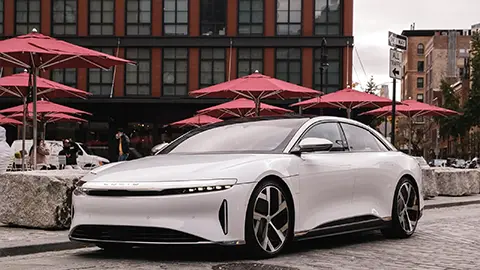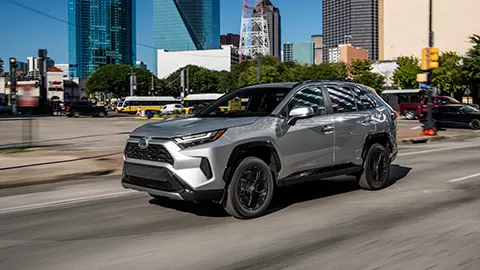Do EVs Work in the Winter?
Perhaps you’ve seen headlines about EVs dying in traffic jams during winter storms and not being able to keep up with their gas (or diesel) filled counterparts. While these stories grab attention, they have been disproven. In fact, electric cars already make up over 90% of Norway’s car sales, a country known for being partially above the Arctic Circle and an average high-temperature in January of 28.8°F (-1.8°C).
Driving in cold weather impacts battery range because your car uses more energy to warm the cabin as well as warming up the battery to maintain its temperature. The air is denser when it’s cold, which means it takes more energy to actually move the car through the air down the road when it's colder out. These tips will help you find the right EV for you with these cold weather challenges in mind!
We hope these seven tips help you find an EV that will make winter driving something you look forward to!
Tip #1: Does It Have a Heat Pump?
Many EVs have a secret weapon to fight the cold - a heat pump. It helps in all conditions (not just the cold!) and the reason it’s ranked #1 on our list.
What exactly is a heat pump? It is a device that moves thermal energy from one part of your car to another to efficiently keep all parts of the car at their ideal temperatures. Similar to heat pumps in homes, modern heat pumps in cars have been updated in recent years and are designed for extreme temperatures, and warm up your car quicker than traditional car heating systems.
A heat pump is incredibly important to have in your new electric car because it uses less of your battery’s energy to maintain temperatures as you drive. That means you can go farther per charge. A heat pump also makes sure your battery is at the right temperature, so when you need to stop to charge, your charging will be quicker in colder temperatures.

Tip #2: What are the Battery Options?
It can be overwhelming and feel like you need a physics degree in advanced materials to decipher EV battery jargon. Before getting overwhelmed, first consider how you plan to use your car.
EVs typically have one of two different types of batteries – a Nickel Manganese Cobalt (NMC) battery or a Lithium Iron Phosphate (LFP) battery. Despite the names, both batteries are lithium-based.
If you will be driving your EV long distances that require fast charging in cold climates on a regular basis, a NMC battery is going to generally be a better choice because NMC batteries are generally the larger battery size and therefore will give you the most range. NMC batteries generally charge faster and more consistently in cold climates. Having a larger battery also has a big impact on charging time in cold temperatures - you will not have to charge the battery to as high of a charging level on a regular basis to get more range, which will protect the overall health of your battery in the long run.
If you will be driving your EV as a commuter car (less than 100 miles per day) and don’t plan to charge at a DC fast charger very often then an LFP battery will work just fine in the cold. LFP batteries are very reliable and can be charged to 100% on a regular basis.
Tip #3: Does It Have All-Wheel Drive (AWD)?
In most all-wheel drive EVs, there are two motors positioned between each axle of the car. This allows the driver to control each wheel independently and change how the car is responding to the road depending on the traction each wheel is seeing. Motors in electric cars respond much faster than their Internal Combustion Engine (ICE) equivalents to changes in road surfaces, which means better overall traction during winter driving.
Plus, more motors means more power for more spirited and fun winter driving. Another perk of AWD in EVs is that traditionally AWD makes ICE cars less efficient. With EVs, it’s a different story - the loss in efficiency is much less, and can even be more efficient than ICE vehicles depending on the model. More efficient EVs means more overall range. Just remember, even if you have AWD, don’t forget to purchase winter tires.

Tip #4: Is There a Cold Weather Package?
A cold weather package, or individual options such as heated seats, heated steering wheel, and heated windshield wipers, can make life with an electric car nicer in the winter.
Cold weather or winter packages are often available for your car - you just need to ask! Heated seats and a heated steering wheel are quick and efficient ways to warm you up instead of warming up the whole car's cabin. This means that instead of cranking up the heat to max, you can set the cabin heat to a lower overall temperature and turn on the heated seats and steering wheel when you get in the car. This allows you to use less energy and still feel warm while your car heats up, which saves your battery energy that translates to range.
Heated windshield wipers are another way to lower the total energy used by your car’s system. Heated wipers make it less likely you’ll need to use your defogger setting on your windows which saves power, in addition to helping melt any snow or ice on your windshield too.
Tip #5: Does the Car Have an “Eco” or “Chill” Mode?
Check if the car has an “Eco” or “Chill” mode. These modes tell the car to use its battery power more efficiently - which also means that the car will accelerate slower. This not only saves you power and gives you more range, but slower acceleration gives the driver more control in low-traction situations.
Tip #6: Can You Set Regenerative Braking in Cold Weather?
All electric cars have regenerative braking in addition to a traditional braking system. This means that when you lift off the pedal or begin to brake the motor will actually become a generator and convert that braking energy into electrical energy it puts back into the battery.
When driving in very slick and icy conditions, having a stronger regenerative braking setting can sometimes cause the car to slide more easily. Having the ability to easily set the regenerative braking to a less aggressive setting can help prevent this.

Tip #7: Does the Car Have Preconditioning?
Battery preconditioning means your battery is topped off, up to temperature and the car is warmed up. When fast charging at a DC charger it’s important to make sure your battery is at the right temperature to accept fast charging – otherwise it’ll take more time and energy to get the battery up to temperature once you’re already at the charger.
Buying a car that allows you to have DC fast charging preconditioning avoids shorter charging stops in the cold and the dreaded EV “coldgating,” which means the battery is cold and the car charges slowly.
















